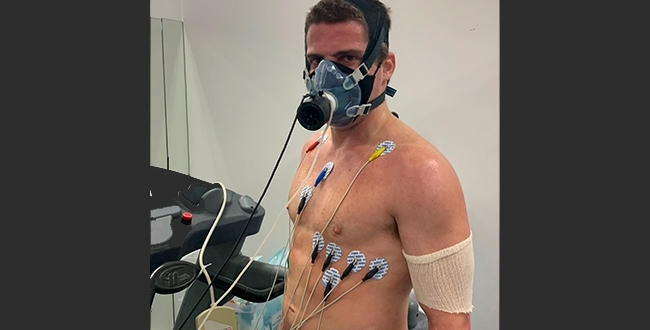


The results of a study by researchers at the University of São Paulo could serve as a basis for new recommendations on health and fitness during the COVID-19 pandemic (photo: Natália Mendes Guardiero).
Published on 01/18/2022
By Maria Fernanda Ziegler | Agência FAPESP – Although wearing a cloth face mask may cause some discomfort, it does not significantly affect respiratory or cardiovascular variables during moderate to vigorous exercise, according to a study involving men and women not trained to play competitive sports.
“The study refutes the myth that it’s bad for you to wear a mask while exercising because it lowers your oxygen saturation, for example. Mask wearing didn’t significantly affect bodily functioning during moderate to intense exercise in our study,” said Bruno Gualano, a professor at the University of São Paulo’s Medical School (FM-USP) in Brazil. Gualano is the last author of an article on the study published on the preprint platform medRxiv and awaiting peer review.
In the study, which was supported by FAPESP and conducted by researchers affiliated with FM-USP, 17 men and 18 women, all healthy, performed a set of varying-intensity treadmill ergospirometry tests designed to measure cardiorespiratory fitness and gas metabolism (inhalation and exhalation) during exercise. The participants ran while wearing a three-layer cloth mask in one session and without the mask in another session so that comparisons could be made.
A wide array of physiological variables were measured during the tests, including respiratory capacity and oxygen consumption. “We also assessed cardiovascular functioning and blood acid-base balance, as well as oxygen saturation,” Gualano said. “The conclusion was that wearing a face mask causes very little disturbance, especially at intensities below maximum effort, which are hugely beneficial to health.”
Compensatory physiological responses
Minor respiratory alterations were observed during high-intensity exercise, when the subject reaches maximum possible effort before becoming exhausted and having to stop. “Even so, the organism can handle this by means of compensatory physiological responses,” Gualano said. “Oxygen saturation, heart rate, perception of effort, lactate levels indicating acid-base balance and blood pressure were all as expected even with mask wearing and at critical intensity.”
The findings from the study can be used as a basis for new recommendations regarding exercise during the pandemic. “Masks shouldn’t be an excuse not to exercise,” he said.
“The pandemic is lasting a long time, and masks plus vaccination are essential to stop the spread of the disease, but it’s also important to keep fit. We found no distinct change in physiological factors between moderate and intense levels of exercise, which are known to be good for health. This means everyone should continue to wear a face mask when indoors. Mask wearing and exercise aren’t mutually exclusive.
“Anyone who wants to exercise at maximum intensity can do so out of doors while keeping their distance from others and choosing a place where they can remove the mask for a period to avoid a loss of performance. In our study, the effects of mask wearing were minimal even at very high intensities.”
Another interesting aspect of the study is that the results were similar for both sexes. “Exercise physiology is very different in men and women, so we expected the effects of mask wearing to differ between the sexes, but that wasn’t the case,” Gualano said.
Olympic Games with masks
The same group of researchers partnered with colleagues at the Federal University of Rio Grande do Norte (UFRN), also in Brazil, to conduct a study of high-performance athletes. “In that study we also found that masks didn’t impair performance. Only perceived effort increased. The athletes complained that wearing a mask was uncomfortable, but their performance didn’t change,” Gualano said.
The study was published before the 2020 Summer Olympic Games were held in Tokyo in July 2021. “In light of all the harm done to sports, and the economic and organizational damage caused when a competitive athlete is infected, we suggested at the time that it would be worth requiring mask wearing during training. Performance wouldn’t be affected and it would be a worthwhile tradeoff,” he said.
High-performance athletes do not usually develop severe COVID-19. “The risk isn’t zero, however,” Gualano said. “Moreover, it’s bad for the sport. They have to isolate, their contacts must be tested, and the athletes take time out to recover. All this is a huge loss for the individuals concerned and for their teams. At the Olympics, we saw cases of athletes who lost the competition because they had contracted the disease. With the new wave in Europe and the United States, the number of cases among athletes has risen sharply, and several leagues could be brought to a stop.”
The researchers are now analyzing mask wearing during exercise in clinical groups and children. “We’re testing to find out about the effects of mask wearing in healthy and obese children during exercise at varying levels of intensity. We want to see if masks are safe for other vulnerable groups as well,” Gualano said.
The article “A cloth facemask causes no major respiratory or cardiovascular perturbations during moderate to heavy exercise” by Natália Mendes Guardieiro, Gabriel Barreto, Felipe Miguel Marticorena, Tamires Nunes Oliveira, Luana Farias de Oliveira, Ana Lucia de Sá Pinto, Danilo Marcelo Leite do Prado, Bryan Saunders and Bruno Gualano is at: https://www.medrxiv.org/content/10.1101/2021.12.14.21267800v1.
Source: https://agencia.fapesp.br/37742